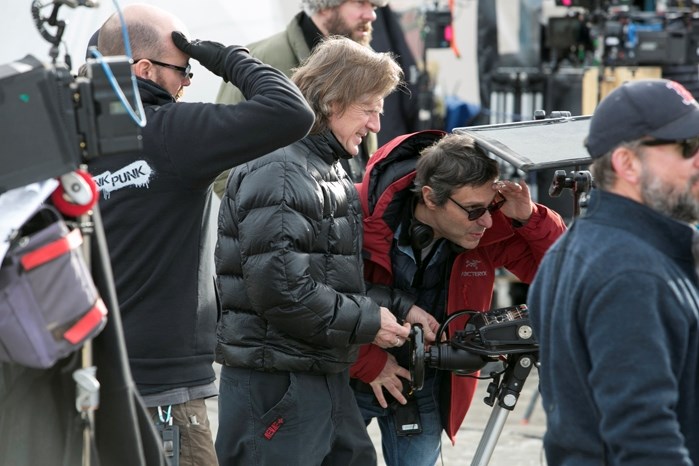In front of the cameras filming scenes of the SyFy thriller Wynonna Earp in Didsbury, there were about 20 actors and some extras.
What got the filming done each day, however, were the 90 to 100 crew members ranging from director Paolo Barzman and the camera, sound and lighting people to the hairdressers, makeup artists, grips, drivers, caterers and location assistants who kept vehicles and pedestrians out of camera range and quiet during filming.
The crew worked in three places through the film day: around the street location where filming the next scene was to take place, in the mobile workshops for the lighting, sound, camera and other equipment parked on 20th Avenue and 20th Street, and in the “circus” – the mobile dressing rooms, makeup studios and offices parked north of the Memorial Centre.
In the final filming for the first season on Jan. 28 and 29, there was a crowd of actors for a mob scene that were watered and fed in the Elks Hall where the cast and crew also took meal breaks.
Didsbury is a seven- to 10-minute drive north of the limit – an hour's drive from Calgary– that film producers prefer when working in Alberta.
In spite of the extra cost, Didsbury has the look that the producers wanted for the outdoor scenes in Purgatory, the western town in which Wynonna Earp, the series' central character, confronts evil.
Perhaps it was the period facades of the buildings along 20th Street that gave the town the sense of nostalgia that the location scouts saw right away.
Perhaps it was the small-town patience and understanding that the film crew got from businesses, pedestrians and motorists who accommodated eight days of minor disruptions when the cameras rolled.
Perhaps it was the solid reputation Didsbury gained in the filming of part of an episode of Fargo.
The angled parking, the absence of traffic lights, the old railway station, the grain elevator on the south end of town and the backdrop of the mountains all contribute to the look of a “classic small town under the wide Alberta sky where anything can happen,” as the series art director Ingrid Jurek describes it.
Perhaps it was all of those visual elements that attracted the producers to Didsbury. In filmmaking if looks are not everything, all the other elements are a distant second.
Melanie Neige Scrofano – Wynonna – a Canadian television and film actress from Ottawa, and a cast that varied through four episodes, turned Didsbury into the chrome western town with, through the camera lens, the kind of edginess that you want for a battle between good and evil.
On four occasions from September to February and for 16 days including setup and takedown, Didsbury was Wynonna's town.
The sound stage for the series is in Calgary, in a warehouse on Blackfoot Trail S.E. The exterior of Shorty's bar was built at the entrance of the Ulla-la Boutique. The interior was on the sound stage.
“It's a bar of sawdust and beer, a large old bar with a copper top, a wall of Wyatt Earp memorabilia for visiting tourists, a jukebox and slot machines, neon lights,” said Jurek.
The crew was, with a few exceptions, Albertans. According to the Calgary Economic Authority, the champion of movie and television filming in southern Alberta, there are 3,000 people who make their living in film.
Calgary has the advantage over Edmonton because it has more infrastructure that its northern rival. The Calgary Film Centre that is slated to open later this year has 50,000 square feet of sound stages and 20,000 square feet of warehouse, workshops and office space.
More than 4,000 students graduate from creative and film industry post-secondary programs each year in the province and there are more than 4,000 creative and film industry businesses in southern Alberta according to Statistics Canada.



